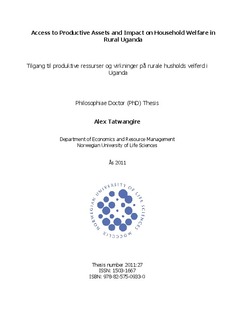| dc.contributor.advisor | Holden, Stein T. | |
| dc.contributor.advisor | Angelsen, Arild | |
| dc.contributor.author | Tatwangire, Alex | |
| dc.coverage.spatial | Uganda | nb_NO |
| dc.date.accessioned | 2017-03-14T14:57:00Z | |
| dc.date.available | 2017-03-14T14:57:00Z | |
| dc.date.issued | 2011 | |
| dc.identifier.isbn | 978-82-575-0933-0 | |
| dc.identifier.issn | 1503-1667 | |
| dc.identifier.uri | http://hdl.handle.net/11250/2434107 | |
| dc.description.abstract | This thesis assesses the impact of access to productive assets on the welfare of rural farm households in Uganda. It consists of an introduction paper and five other independent papers. Paper I provides robust empirical evidence on the poverty reducing impact of land access through market and non-market avenues in rural Uganda. The paper found significant poverty reduction effects of increased land access in form of owned, operated and market accessed land after controlling for the endogeneity bias of land access and welfare effects of the unobserved heterogeneity.
Paper II employs the income approach to compute the value of household human capital. It then estimates the impact of changes in human capital endowment and health shocks to human capital on the real household expenditure per adult-equivalent. The paper found positive and highly significant poverty reducing effects of increased investment in human capital after controlling for the endogeneity bias of human capital variation, but the welfare effects of unexpected death and sickness shocks were insignificant.
Paper III estimates the impact of the endowment of young children on household expenditure per adult-equivalent. The analysis found small and insignificant impact of increased number and adult-equivalent of young children on household welfare after controlling for the endogeneity of children, differences in the number of children, and effects of adult human capital trade-offs. Limited short-term economic benefits of children and strong trade-off between adult human capital and young children in a household were found.
Paper IV assesses the impact of access to livestock holdings and productive farm equipments on expenditure per adult-equivalent. The analysis found significant welfare increasing effects of access to additional livestock holdings and productive farm equipments, after controlling for the endogeneity of each productive asset and unobserved heterogeneity. The study indicates high levels of inequality and strong positive correlation between each asset endowment and household expenditure.
Paper V provides a synthesis of the relative poverty reduction impacts of household access to four productive assets; land operated; human capital; livestock endowments; and physical farm equipments in rural Uganda. A translog production function based on first-differenced data and a semiparametric statistical smoothing method was applied to assess the returns to each asset and the likely asset interaction effects. An increase of each of four assets was found to generate strong and significant poverty reduction effects. Human capital and livestock, and livestock and farm equipment appeared to be potential substitutes in the household production process. | nb_NO |
| dc.language.iso | eng | nb_NO |
| dc.publisher | Norwegian University of Life Sciences, Ås | nb_NO |
| dc.relation.ispartofseries | PhD Thesis;2011:27 | |
| dc.rights | Attribution-NonCommercial-NoDerivatives 4.0 Internasjonal | * |
| dc.rights.uri | http://creativecommons.org/licenses/by-nc-nd/4.0/deed.no | * |
| dc.title | Access to productive assets and impact on household welfare in rural Uganda | nb_NO |
| dc.title.alternative | Tilgang til produktive ressurser og virkninger på rurale husholds velferd i Uganda | nb_NO |
| dc.type | Doctoral thesis | nb_NO |
| dc.subject.nsi | VDP::Social science: 200::Economics: 210::Economics: 212 | nb_NO |
| dc.source.pagenumber | 253 | nb_NO |

